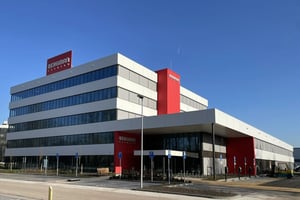Companies structurally underutilise talent, according to former director, commissioner, and mentor of management teams, Eric Koenen. Not because the talent isn’t there, but because the way in which companies are organised is incapable of accessing the available intelligence in the collective effectively. In his book, Samen slimmer (Smarter Together), set for publication shortly, Koenen pleads for an alternative approach based on loosely knit groups of people — ‘swarms’ — joined together around specific problems and issues.
You coach many (executive) management teams. These teams mostly consist of individuals with above-average intelligence. Even so, you state that this intelligence does not ‘cumulate’, by definition, and that, in certain situations, there is even a risk of a kind of collective stupidity. How does that work?
‘It’s a fact that people are only as intelligent as their emotions allow them to be. And even intelligent people can get into destructive patterns. You can see that happening when people stop reflecting on what is going on, various irrationalities take over, and people become incapable of coming together and saying the things that really need to be said. Councils of specialists in hospitals are a well-known example: at some point, eight highly intelligent, highly educated professionals will gradally deteriorate into a group of toddlers in a sandpit, throwing around shovels, rakes and sand. And the risk of medical errors increases when the resolution of complex problems and issues hinges on on effective coordination. You can see this mechanism at work throughout the business community, albeit less visible on the surface. Imtech is a good example of a company that went down as a result of some such destructive patterns, even though plenty of exceptional, intelligent people worked there.’
Has this not always been the case?
‘Yes, but: the importance of solving the barriers to utilisation of the collective intelligence grows as the complexity of the problems and issues increases. And this complexity is growing exponentially. Right now, developments are moving so quickly that managers are continually playing catch-up and the risks of collective stupidity continue to grow. And that is risky. The famous strategist, Carl Von Clausewitz, once said: ‘Generals are always prepared for the previous war’. You also see this happening at the top of companies, where they try to build an organisation that should have been in place three years ago, instead of a future-proof organisation. The traditional management structure with people at the top who all think they know best and can think four steps ahead is beginning to become less and less effective. I’m not saying that we can’t handle the complexity intellectually, but that we must organise our intelligence differently, in a way that does “cumulate”.’
What alternative do you recommend?
‘In my opinion, somebody who is very intelligent doesn’t have more brain cells, but more connections. The concept of "teaming" developed at Harvard works well here. Instead of viewing an organisation as an entity with various compartments with a specific structure, I look at an organisation as a collection of different types of intelligence — talent, if you will — on the one end, and a set of complex problems and issues on the other end. The key is then to arrange the right talent briefly around such a complex problem or issue. Under inviting conditions, with lots of room to investigate and test, and without — or with a very limited — hierarchical structure. This way, you make the best possible use of swarm intelligence, without giving people the chance to develop patterns that will limit how they apply this intelligence.’
And executive management’s role: deciding who to assign to what problem?
‘From a management perspective, the challenge is indeed to formulate these problems and issues as precisely as possible and to have a good idea of the different types of talent available and required. I also recommend that an organisation only define four or five of these complex problems or issues. Management agendas with dozens of strategic issues are doomed to fail. Furthermore, executive management must ensure that a culture of psychological safety prevails within the swarms. Everyone’s insight counts to an equal degree. For instance, you may also choose to include someone from an entirely different world in the team, like a philosopher or artist. You then organise a deviant type in that system, someone who differs from the rest. It keeps everyone on their toes and generates other questions.’
Should organisations immediately change course so they can profit more out of swarm intelligence?
‘There are so many ways to organise collective intelligence, and starting small is a feasible option. When I was still a manager in charge of innovations at Cofely Nederland, I started on my own — in other words, without the established consultancy firms. When you fall into a pattern where you hire consultants for every problem, you’re really telling your employees that they don’t have any problem-solving skills. That is disastrous. So, I gave everyone a Moleskine notebook with the words: “In the coming four weeks, write down everything that you think is strange.” Afterwards, we got together and discussed the observations. The fun thing about that is, for the cost of a few notebooks, you end up with an analysis that’s pretty much the same quality as one from McKinsey. Organisations develop in the direction of the questions that they dare to ask.’
Swarm intelligence in nature
The term swarm intelligence also refers to another phenomenon around the world, namely, a form of artificial intelligence (AI) inspired by the insect kingdom. Comparable to how honey bees migrate in nature and ants create perfect paths to food sources kilometres away, AI systems can use input from a great many different users and/or sensors to optimise the performance of the system as a whole. An example is Waze, a road navigation app popular in the US, which uses the swarm intelligence of all users to keep the digital maps up to date in real time. Swarm intelligence has also been used before by traders to predict market movements and by retailers to predict sales.
Although the concept of swarm intelligence is not new, the arrival of edge computing (increased computing power at the location where data is collected, in other words, not in the cloud but on the edge of the network — eds.) has given further momentum to the concept. Louis Rosenberg, CEO of the swarm platform Unanimous AI, expects the importance of swarm intelligence to increase dramatically for businesses in two areas, in particular: to identify new growth opportunities and to anticipate and manage disruptions. Rosenberg: ‘Although algorithms can predict market trends, the final investment decisions are made in the boardroom, based on information from within the organisation. The only problem is: people tell their superiors what they want to hear. In a swarm, where everyone is equal and anonymous, you get much more accurate insights, and you can predict potential areas for market growth much more reliably.’
At Gatwick, one of the world’s busiest airports, they use swarm intelligence to optimise through-flow. An AI system based on swarm intelligence, named FlightID, collects all the data that typically influence the departure times, up to the average historical delay on rainy days, per specific airline company.
Read more: The leader of the future will do more innovating and less controlling













